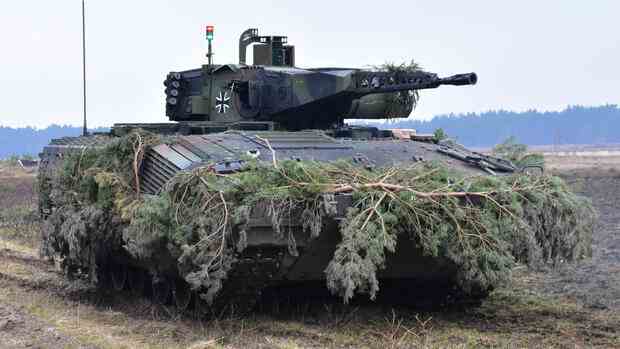There are always defects on the military vehicle. Now, in one exercise, 18 copies failed in quick succession.
(Photo: imago images/Sven Eckelkamp)
Dusseldorf, Berlin The armaments companies Rheinmetall and Krauss-Maffei Wegmann (KMW) want to repair the 18 defective Puma infantry fighting vehicles in the Bundeswehr before the end of this year. The Handelsblatt found out on Tuesday from Berlin security circles.
After the embarrassing series of breakdowns, however, the companies continued to wait to be able to form their own picture of the defective systems. The assessments of the extent of the damage are therefore only based on information from the Bundeswehr. Neither company wanted to comment officially.
A lot is at stake for the corporations. Federal Defense Minister Christine Lambrecht (SPD) has further increased the pressure. During a visit to the troops on Tuesday in Slovakia, the minister emphasized that she now sees the industry “in the lead”. It was a “self-evident fact” that the corporations would eliminate the defects found and repair the tanks. If that doesn’t work, you’ll have to think about an exit.
A follow-up order for another 50 Puma tanks in the coming year seemed only a formality. Now, according to information from ministry circles, it is even questionable whether the agreed retrofitting will be implemented on the tanks that have already been procured.
Top jobs of the day
Find the best jobs now and
be notified by email.
The Budget Committee of the Bundestag had already approved the funds for this upgrade. But contrary to what was planned, the corresponding contract with the industry was not signed on Monday.
The Bundeswehr’s Puma tanks were certified as “combat-ready”.
The simultaneous failure of the 18 Puma armored personnel carriers has been causing excitement among the Bundeswehr, the Ministry of Defense and manufacturers for days. Specifically, it is about a specially retrofitted variant for the quickly deployable VJTF intervention unit of NATO. These specimens were already certified as “combat fit”.
Lambrecht questions the future of the Puma infantry fighting vehicle
But there are serious doubts about this. During exercises in the army’s target practice center in Bergen, all systems are said to have gradually failed. As a result, Major General Ruprecht von Butler, commander of the 10th Panzer Division, wrote an incendiary letter to the Ministry of Defence, among others.
Now the error analysis is running. On Monday, representatives of the Bundeswehr, the Ministry of Defense and manufacturers met for a crisis meeting. The defective tanks are currently being transported back to the Bundeswehr base in the Bavarian town of Regen.
In the meantime, NATO can rely on Germany to meet its obligations, emphasized the minister. “We already planned the Marder infantry fighting vehicle during the preparations and that has proven to be wise.”
>> Read about this: Bundeswehr uses old Marder tanks for NATO spearheads – and will not order any new Pumas for the time being
The fact that Germany now has to resort to the approximately 50-year-old Marder is just the latest in a series of embarrassing reports about the Puma, which is considered one of the most ambitious projects in the German defense industry. Upgraded with the latest technology and armament, the vehicle was intended to strengthen the offensive power of the Bundeswehr.
There are two main problems with the Puma
There are two main reasons why there are always problems with the system: On the one hand, two companies, KMW and Rheinmetall, were commissioned, some of which tend to work against each other rather than with each other. On the other hand, the mission profile has changed several times since planning in the mid-1990s.
The federal government ordered changes again and again. Instead of being used for static warfare, the Puma had to be planned for missions such as that in Afghanistan. This meant that the vehicles had to be protected not primarily against fire from the front, but from all sides.
However, such a change has a chain of consequences: the reinforcement of the armor meant that specifications for weight and dimensions could not be met. In order for the Puma to be loaded onto military aircraft, mountable side armor was installed.
The distribution of work in production also proved to be a disadvantage. Since the Puma was built at different locations, no two tanks are the same, reports representatives of the Bundeswehr. Even the dimensions did not match in many cases.
At the same time, changes were always a reason for discussion between managers from Rheinmetall and KMW. The Puma was only delivered to the Bundeswehr in 2015 with a considerable delay. At the handover ceremony, the then KMW boss Frank Haun was still convinced that he had a real export hit in his range. Countries such as Indonesia, Singapore and Qatar were considered potential sales markets. So far, the Bundeswehr has remained the only customer.
More: The “Puma” brakes Rheinmetall – the share loses significantly
